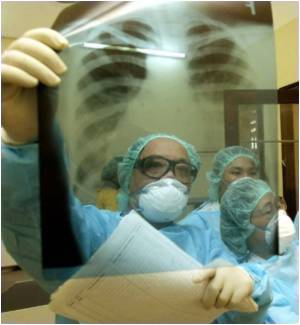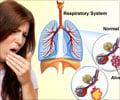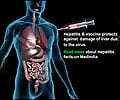Smokers with low bilirubin levels are at a higher risk for lung cancer incidence and mortality compared to those who had highest bilirubin levels, finds study.

Most patients with lung cancer are diagnosed at inoperable advanced stages and the prognosis is particularly dismal, with the five-year survival rate for stage 3b and stage 4 diseases being 5 percent and 1 percent, respectively, according to Wu. Biomarkers are urgently needed for improving risk prediction for lung cancer beyond smoking variables, and serum metabolites are emerging as promising markers.
Wu and colleagues used a unique multiphase study design for the metabolomics profiling of serum samples. In the initial discovery phase, the researchers recruited 20 healthy individuals, 20 patients with early-stage non-small cell lung cancer and 20 patients with late-stage non-small cell lung cancer, matched for age and gender. They performed global, unbiased metabolite profiling using the serum from patients blood samples. They then validated the top three differentially expressed metabolites in the next phase involving two additional populations with a total of 519 healthy individuals and patients with non-small cell lung cancer.
The metabolite bilirubin emerged as the most promising marker, and the researchers further validated this finding in the third phase, which included a large Taiwanese prospective cohort of 435,985 individuals.
Among the Taiwanese cohort, the researchers found a 7.02 incidence rate of lung cancer per 10,000 person-years for men with bilirubin levels of 0.68 mg/dL or less, compared with an incidence rate of 3.73 among men whose bilirubin levels were 1.12 mg/dL or more. This translates into a 51 percent increase in the risk for developing lung cancer for patients with low bilirubin. Researchers also found a lung cancer-specific mortality rate of 4.84 for men with the lowest levels of bilirubin compared with a mortality rate of 2.46 for men with the highest bilirubin levels - a 59 percent increase in lung cancer-specific mortality among those with the lowest bilirubin levels.
Looking only at smokers, Wu and her colleagues found that those with the lowest levels of bilirubin had a 69 percent increase in the risk for lung cancer development and a 76 percent increase in mortality compared with smokers with the highest levels of bilirubin. In contrast, there was no significant effect of bilirubin in "never-smokers."
Advertisement
"The ability to use low bilirubin to identify higher-risk smokers, over and above the number of pack years smokers report having smoked, has significant public health impact in reducing lung cancer burden," said Wu. "Low levels of bilirubin, established as an objective risk index for lung cancer incidence and mortality, may be viewed by smokers as an urgent health warning to drive them to quit."
Advertisement
Authors: Fanmao Zhang, Chi Pang Wen, Dong Liang, Heath Skinner, Jian Gu, Wong-Ho Chow, Yuanqing Ye, Michelle A.T. Hildebrandt, Xia Pu, Maosheng Huang, Min Kuang Tsai, Chwen Keng Tsao, Xifeng Wu. UT MD Anderson Cancer Ctr., Houston, TX, National Health Research Institutes, Zhunan, Taiwan, Texas Southern University, Houston, TX, MJ Health Management Institution, Taipei, Taiwan
Background: Lung cancer is the leading cause of cancer death in the United States. Cost-effective screening and early detection is essential for reducing lung cancer mortality. Serum metabolites are emerging as promising biomarkers for improving risk prediction and early detection of lung cancer.
Methods: In the discovery phase, we performed global, unbiased metabolomic profiling in serum samples from 20 healthy controls, 20 early stage, and 20 late stage lung cancer patients who were matched on age and gender. We then selected three differentially expressed metabolites for validation in two additional case control populations, followed by final validation of one metabolite in a large Taiwanese prospective cohort of 435,985 individuals.
Results: A total of 403 named metabolites were identified by metabolomic profiling in the discovery phase, with 306 metabolites remaining after initial quality assurance. Of these, 29 metabolites exhibited a significant trend when comparing normal controls, early stage and late stage lung cancer cases. Three of the top differentially expressed metabolites, gamma-glutamylalanine, bilirubin and allantoin, were selected and validated in two additional sets of subjects, one set comprised of 50 controls, 50 early stage and 50 late stage lung cancer cases, and the second comprised of 123 controls, 123 early stage and 123 late stage lung cancer cases. The most promising metabolite, bilirubin was further validated in a large prospective cohort. In this cohort, the incidence rate of lung cancer per 10,000 person-years in men was 3.73 (95% confidence interval [CI], 3.13-4.43) in the highest quartile of bilirubin level compared to 7.02 (95% CI, 6.16-7.99) in the lowest quartile, which translates into a 38% increase in lung cancer incidence for the low bilirubin group (P=0.003). The corresponding lung cancer specific mortality rate in men was 2.46 (95% CI, 2.02-3.00) in the highest quartile compared to 4.84 (95% CI, 4.19-5.60) in the lowest quartile, a 53% increase in lung cancer specific mortality for the low bilirubin group (P<0.001). Finally, we found that the inverse relationship between serum bilirubin and lung cancer was only significant in ever-smokers but not never-smokers and there was a significant joint effect between bilirubin level and smoking status on both lung cancer incidence and mortality, indicating the importance of bilirubin in ever-smokers independent of smoking.
Conclusions: Smokers with low bilirubin levels had significantly increased risks for both lung cancer incidence and mortality. Serum bilirubin is a valuable biomarker for lung cancer risk prediction in ever-smokers.
Source-Newswise















